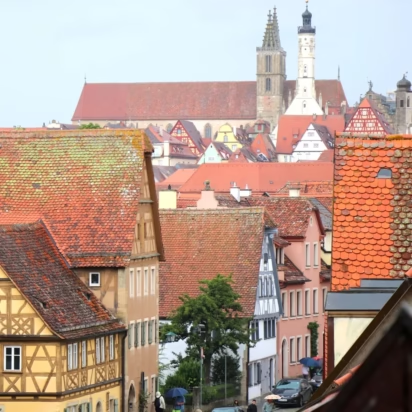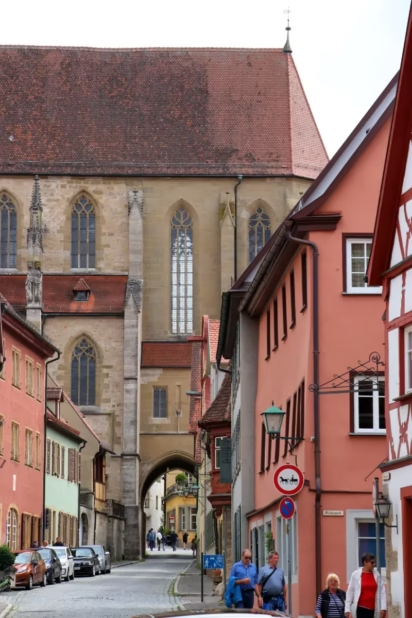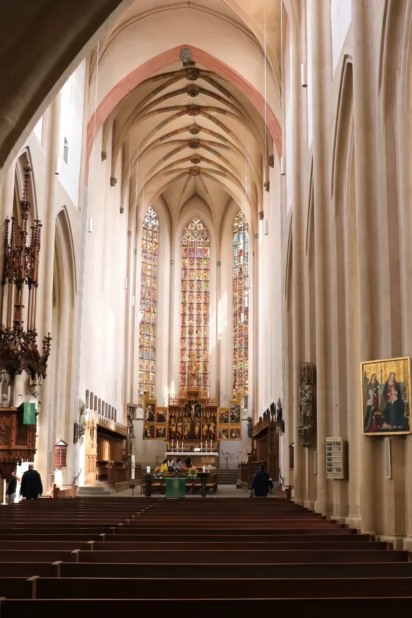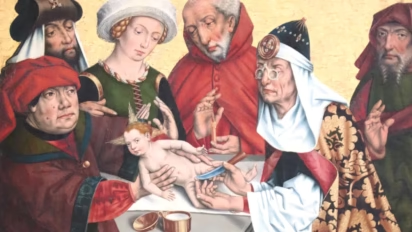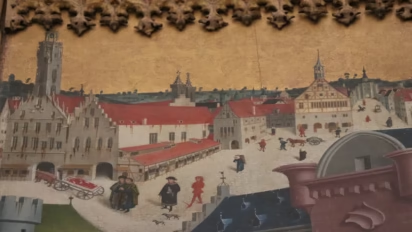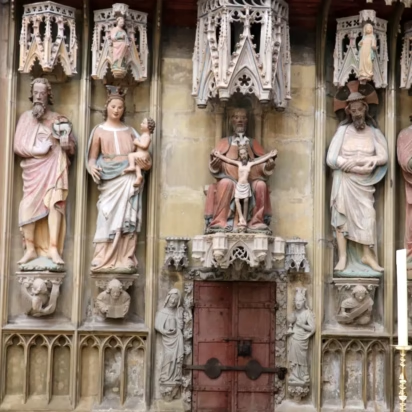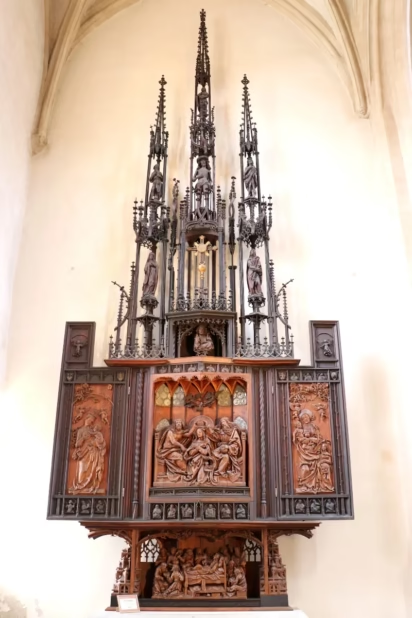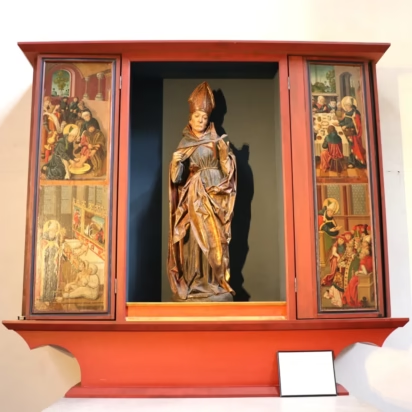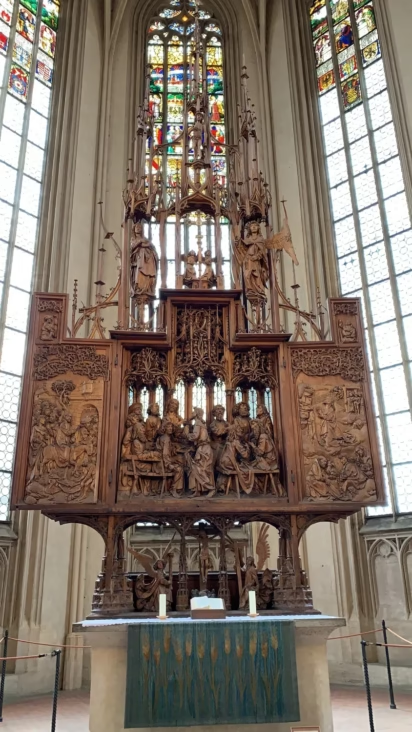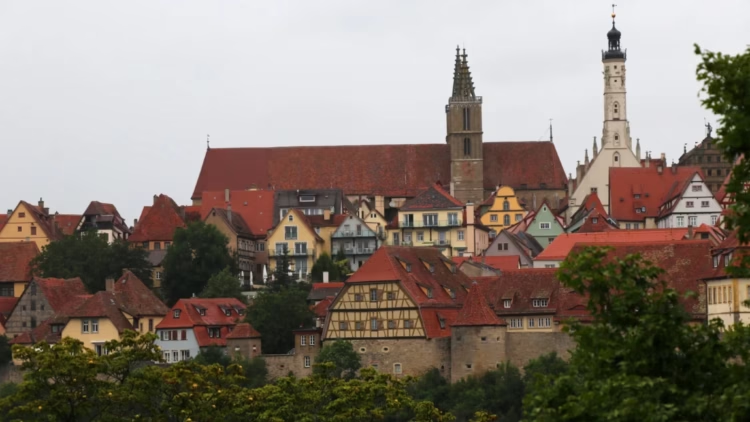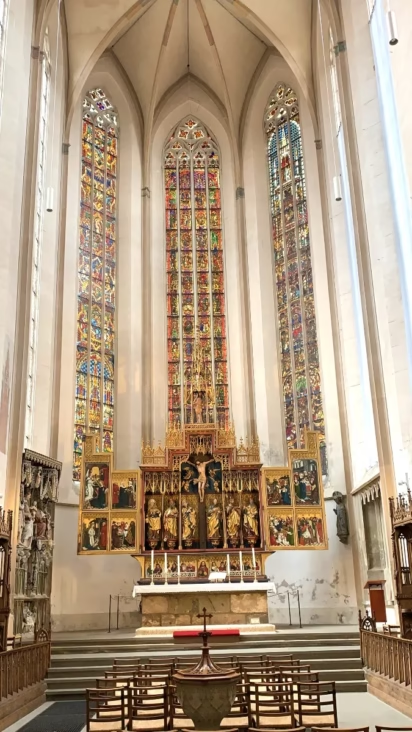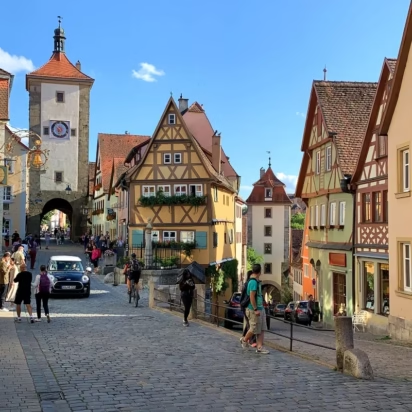The high Gothic St.-Jakobs-Kirche (Church of St James) in Rothenburg ob der Tauber is full of art, including the Holy Blood Altar carved by Tilman Riemenschneider.

The St.-Jakobs-Kirche (Church of St James) is the largest church in the wall-enclosed medieval city of Rothenburg ob der Tauber in northern Bavaria in Germany. This High Gothic church is filled with art in addition to the world-famous Holy Blood Altar (Heilig-Blut-Altar) by Tilman Riemenschneider — Germany’s most renowned woodcarver. Further altars, sculptures, paintings, and centuries-old stained-glass windows help to make this church one of the top cultural sights to see when traveling along the Romantic Road in Germany. Admission is cheap and opening hours are long. Day-trip tours to Rothenburg are often possible from Frankfurt and Munich.
St.-Jakobs-Kirche (Church of St James) in Rothenburg
The St.-Jakobs-Kirche (St James Church) is the largest church in Rothenburg ob der Tauber. Its sheer size confirms that Rothenburg, now a small town, was an important and relatively wealthy city in the Middle Ages. Rothenburg had many further churches, but St.-Jakobs with its Holy Blood relic was a major stop on the pilgrim’s route to Santiago de Compostela (Jakobsweg) and thus attracted the highest number of visitors and income.
The high Gothic basilica was built for the German Order to replace a smaller existing Romanesque church in three main construction phases: the eastern choir (Ostchor) between 1311 and 1322, the nave (Hauptschiff) between 1373 and 1436, and the western choir (Westchor) between 1450 and 1471, as a bridge over the main road.
The Order of German Knights (Deutscher Ritterorden), also Teutonic Knights, was very active in this region during the Middle Ages and often in dispute with other orders and groups in Rothenburg. After Brandenburg (Prussia) accepted the Reformation, the Roman Catholic branch established a new headquarters of the Teutonic Order in nearby Bad Mergentheim from 1525 until the forced abolition of the order in 1809. It later reestablished itself in Vienna, from where it still operates as a charitable foundation.
The St James Church dominates the skyline of Rothenburg. Not only is it built on the highest spot in town but it also has two tall spires. The south tower is 55.2 m (180 ft) tall, while the slightly more slender north tower is 57.5 m (189 ft).
According to tradition, the south tower was built by the master and the north tower by the apprentices. When he saw that theirs was more beautiful, he threw himself off the north tower. His dog jumped after him and is remembered in a gargoyle.
Art in the St.-Jakobs-Kirche (St James Church) in Rothenburg
The St.-Jakobs-Kirche (St James Church) in Rothenburg ob der Tauber has so much art, it is often hard to remember that the church has been Evangelisch (Lutheran / Protestant) since the 16th century.
Much of the art — foremost the magnificent world-famous Holy Blood Altar by Tilman Riemenschneider — is furthermore very much Roman Catholic in spirit.
The interior of the triple nave basilica feels spacious with tall slender columns and many windows. The nave is relatively narrow, making the only very lightly decorated vaulting appear especially high.
Upon entry, the eye is immediately drawn to the apse in the east where the high altar rests in front of colorful 17-m-high (56 ft) stained-glass windows. Many are from around 1400 and illustrate scenes from the life of Mary, Christ, and other biblical events, mostly from the New Testament.
The famous Holy Blood Altar is in the western choir, behind the modern organ. It cannot be seen from the entrance or indeed the nave of the church. However, it is worth going up the flight of 32 stairs first if that area seems free of tourist groups before proceeding to the front of the church.
→ See Tilman Riemenschneider’s Holy Blood Altar in Rothenburg ob der Tauber for a description and more photos of this magnificent work of art.
Main Altar in St James Church in Rothenburg

The high Gothic Main Altar (Hauptaltar) is also known as the Twelve Apostles Altar (Zwölfbotenaltar). It is one of the most impressive of its kind in Germany. It was carved by Swabian craftsmen in 1466, while the paintings are by Friedrich Herlin.
At the center is Christ on the Cross surrounded by four flying angels symbolizing faith, prayer, doubt, and unbelief. To the left of the cross are Mary, St James, and Elizabeth. Saints John, Leonhard, and Antonius are on the right. St James here, as in many other works in the church, is easily identifiable from the scallop shell pinned to his pilgrim’s hat.

On the predella is Christ surrounded by his twelve apostles, each painted with his apostolic symbol and named underneath.
Wing Paintings of the Main Altar
The paintings on the inside wings:
- Left: Annunciation, Visitation (Mary visiting Elizabeth), the Nativity (note the baby directly on the ground), and the Circumcision (note the pince-nez glasses of the mohel).
- Right: Adoration of the Magi, Presentation in the Temple, Death of Mary (double panels).
It is worth going to the back of the altar to see the outside paintings of the altar wings. These tell of events related to St James on the wings and scenes of the final judgment, with paintings of hell on the back of the main altar too.
With the doors closed, center top: execution of James by decapitation and his body being carted into a medieval city. This is clearly the market square of Rothenburg, making this one of the oldest depictions of an identifiable cityscape in German art.
Pilgrims on the Camino de Santiago

The rest of the panels tell the story of pilgrims on the Jakobsweg — the route to the grave of St James in Santiago de Compostela in Spain:
- While dining, the innkeeper hides a golden cup in the bags of a traveler.
- The theft is reported and the cup is discovered in a bag. A boy admits to the theft to protect his father and is hanged.
- The grieving father discovers his son alive on the gallows — as a pilgrim, he was protected by St James! — and rushes back to the inn in the company of the judges.
- The innkeeper declares the boy is guilty and as certainly dead as the chicken on his grill spit. However, the chicken is suddenly alive and flies away, confirming the boy’s innocence.
- The son is rescued from the gallows and continues his pilgrimage with his father. The dishonest innkeeper is led to the gallows to be hanged.
The good condition of this altar is partly due to it being mostly closed after the Reformation, as the saints were too Roman Catholic. The legend of St James was overpainted with passion scenes. Only the uncontroversial backgrounds of the two central panels were left uncovered. The overpainting was removed in 1922.
Art in the Choir
The 14th-century Tabernacle of St James (Sakramentshaus), to the left of the main altar, is an interesting high Gothic tabernacle to host implements related to the sacrament.
It has a very unusual portrayal of the Holy Trinity with a small Christ standing in the lap of God the Father while the Dove of the Holy Spirit is between them.
The choir stalls (Chorgestühl) were locally produced in 1514. The shields and portraits above the choir stall are from benefactors and senior clergy.
Statues of Peter and Michael are near the entrance to the nave.
Art in the Nave and Side Chapels of St-Jakob in Rothenburg
Many of the statues and paintings in the nave and side chapels are of impressive artistic quality but mostly by unknown artists.
Some sculptures, such as St Christopher and St George Slaying the Dragon, are easy to identify. Note the painting by Friedrich Herlin of St Barbara and Maria (third left pillar from the front in the nave).
Two further smaller altars placed in the front of the church on either side of the eastern choir are worth noting:
The Maria Altar (Marienaltar) on the left / north dates from around 1520. It is by unknown artists but is often attributed to followers of Riemenschneider.
The scenes are very “unprotestant” – Coronation of the Virgin (center), Madonna and Child (left), St Anne with Mary and Child (Anna Selbdritt) (right), and Death of the Virgin (on the predella).
The painted statue of Louis of Toulouse (1274-1297) on the altar to the right / south side is an early work by Riemenschneider. The paintings are by Jakob Mülholzer.
St Louis gave up all his royal titles and claims in order to become a Franciscan friar. He was appointed bishop of Toulouse aged 23 (royal connections helped), but died within the year. He is not that well known in the English-speaking world, but is celebrated in parts of France, Spain, and Italy.
One of the first large bronzes cast since antiquity was Donatello’s sculpture of St Louis for the Orsanmichele Church. It is now in the refectory of Santa Croce in Florence.
Holy Blood Altar of Tilman Riemenschneider
At the back of the church, in the west, is the 5,000-pipe organ installed in 1968. Behind it in the western apse hides the true cultural treasure of the Jakobs-Kirche — the Holy Blood Altar.
- The church arranges organ recitals on many Wednesday evenings from June to September.
Tilman Riemenschneider, Germany’s most famous woodcarver, created the Heilig-Blut-Altar around 1500 to house the relic of the holy blood. This unpainted lime-wood triptych altar soars nearly 10 m (33 ft) towards heaven.
The main theme is the Last Supper, where Riemenschneider placed Judas unusually at the physical center of the scene rather than Christ.
There is only a small crucifixion at the bottom of the altar in the predella because this work is all about the Eucharist, which of course first occurred at The Last Supper.
→ For a fuller description and photos of this magnificent altar and other artwork by Tilman Riemenschneider, see The Holy Blood Altar by Tilman Riemenschneider in the St.-Jakobs-Kirche in Rothenburg ob der Tauber.
Visitor Information: St.-Jakobs-Kirche (St James) in Rothenburg
The St.-Jakobs-Kirche (Church of St James) in Rothenburg ob der Tauber is open daily:
- January to March & November: 11:00 — 14:00
- April to September: 10:00 — 18:00
- October and December 10:00 — 17:00
The church arranges short 30-minute organ concerts on most Wednesday afternoons at 17:00 from June to September.
The best times to visit are generally in the morning when the sun shines through the magnificent stained glass windows in the eastern choir. Light conditions are similarly worse in the late afternoon when it may be too strong from the back to easily see (and especially photograph) details of the Holy Blood Altar.
Church services (plus a free guided tour if desired) in German are on Sundays and religious holidays at 9:30.
Admission is €3.50 for adults, €2 for scholars and students over 12. This is one of the very few churches in Bavaria that charges admission but entry is still cheaper (to see more) than the Herrgottskirche in nearby Creglingen charges to see the equally impressive Riemenschneider Altar of the Virgin Mary (Marienaltar).
Guided tours are free — often in English on Saturday afternoons, twice daily in German — or hire an audio guide.
More on Rothenburg ob der Tauber
For more on the Rothenburg ob der Tauber and nearby sights on the Romantic Road:
- Top Sights on the Romantische Straße with Romantic Road Map
- Walk on the Ramparts and Sentry Walk on the Wall of Rothenburg
- Visit the St.-Jakobs-Kirche (St James Church) with the Tilman Riemenschneider Holy Blood Altar
- Visit the Medieval Crime Museum
- Visit the Wolfgang’s Church in the Klingenbastei
- See the Herrgottskirche with Tilman Riemenschneider Altar of the Virgin in nearby Creglingen
- Transportation to Rothenburg ob der Tauber – Driving or Take the Train
- Bus Day-Trip Tours are often available from Frankfurt or Munich.
- Hotel prices in Rothenburg are surprisingly reasonable, except over weekends.
- Save with the Bayern-Ticket on Train Transportation in Bavaria
- Get online quotations for taxis and airport shuttles from Frankfurt or Munich airports.
